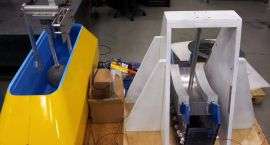A revolution in wave energy

A Spanish and Norwegian duo weren't deterred by the cancelling of renewables projects – they turned to EUROGIA to help them develop a prototype to capture wave energy.
In the long-term our cities desperately need renewable energy to power them. But during the global crisis, companies have scrapped projects as funding dried up. Not Spain's metal machinery specialists Mecánica Industrial Buelna (MIB). Despite a sharp downturn in its home country, MIB invested in a two-year-long research project to develop a prototype to capture wave energy.
It took the plunge with the help of EUROGIA and Norwegian partner, the Norwegian University of Science and Technology (NTNU). It needed to put its wave energy system inside a buoy off the windy northern Spanish coast of Cantabria. "Placing a buoy in the sea costs millions of euros because you need to meet all kinds of environmental regulations and ensure the buoy doesn't corrode," explained Ignacio Cobo, engineer and project coordinator.
Funding from the Spanish state-funded Centre for the Development of Industrial Technology and from Norway's Sintef was vital.
Spain and Norway are two countries with coastlines with huge potential for wave energy. Wave energy is potentially so good because waves contain a power that is even more intense than wind. However, in the intensity lies one of the obstacles in developing effective systems that can be placed in the ocean and resist damage.
Challenging field
Project Seaquest studied the best shape of the buoy to be used and placed a direct wave converter inside – an electrical generator coupled directly to the buoy to capture the most energy possible. "The simplicity of the design is its real success – it has very few electrical components to get damaged," said Cobo.
Since Seaquest finished in 2013, the NTNU has published academic papers on the developments achieved on the project and MIB has continued working on ways to commercialise the system, most recently introducing it into a canal in Cantabria. "It's been difficult to scale it up to an industrial level but we hope to be able to sell the system to investors in the next few years," said Cobo.
His company is determined that it's worth battling on with research given the benefits represented by wave energy. With countries needing to cut their reliance on fossil fuels, the World Energy Council, a network of state and private energy players, has estimated about 2 terawatts could be produced from the oceans via wave power - double the world's electricity production.
With the technologies to capture wave power still very much in their infancy, the developments made by Seaquest have put MIB ahead of competitors in the field. They are hoping to secure funding for further research through Horizon 2020. "In research and development, this has really put us on the map," said Cobo.
More information: For more information, see: www.eurogia.com/projects/eurog … 6-seaquest.html?mn=7
Provided by Eureka


















